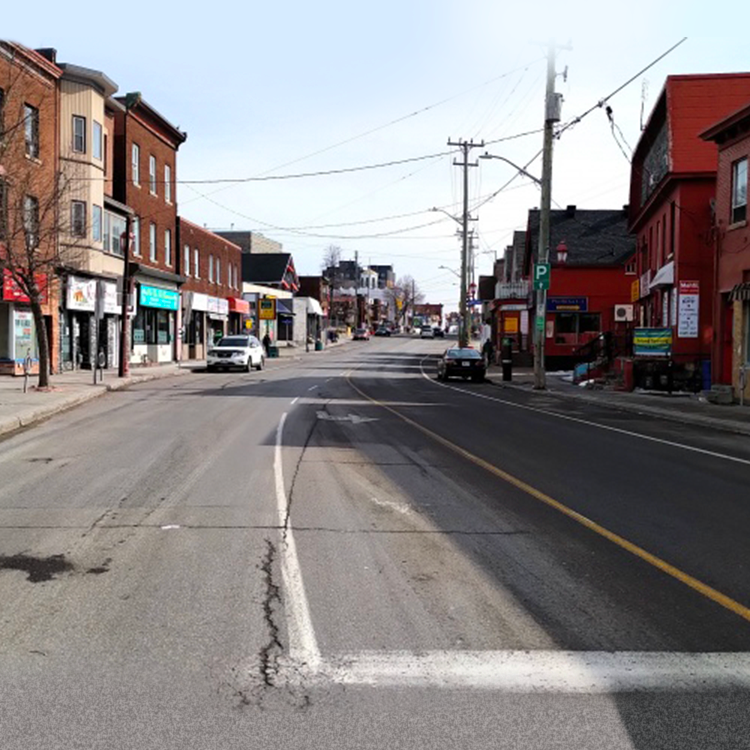Straying from the path: how COVID-19 will change the design of our cities.

It’s been a tough few weeks for all of us. Small businesses are struggling and our traditional, walkable main streets are void of the pedestrian traffic that independent stores depend on to stay afloat.
Some have closed outright, while others are taking steps to keep their doors open by offering take-out and delivery options for groceries, sandwiches and other necessities. Governments are offering support, at least to large businesses and individuals who suddenly find themselves out of work.
What has quickly become evident is that we’re not just looking at a short-term societal change, but rather a new way of thinking about how we approach the design of our cities.
With fewer motorists commuting to work, normally busy roads are largely empty. This starkly illustrates just how much of our city is devoted to cars and moving people quickly through the city from one place to another, without stopping to experience the sense of place we’re passing through. Given the lack of vehicle traffic, an online petition to open up the NCC’s parkways to cyclists is attracting attention. However, mobilizing forces to make this happen in a short time frame is likely tough.
Meanwhile, as we try to keep physical distance between us, we realize how narrow our sidewalks are. As we try to keep our physical distance, picture how challenging it is to navigate narrow sidewalks at the best of times, let alone when they are covered in snow or ice. Now picture this as being an everyday occurrence if you are pushing a stroller or using a wheelchair.
Maybe it’s time to rethink equity in the built environment. What if we devoted more of our street space to cycling and walking? What if instead of “flex space” on Elgin or Queen streets, these spaces were dedicated for walking, separated cycling lanes and bike parking? Perhaps our planning goals should be to maintain physical distance while forging communities so that small businesses can thrive.
Space within density
Over the years, our urban places have become denser – as they should. We need greater density to make transit efficient and promote the walkable and bikeable communities that we need to achieve our sustainability goals.
But what our current crisis is teaching us is what urbanists, architects and planners have been saying for years: Social spaces within the density matter. We need parks where we can create community and establish social cohesion while finding the soothing personal space we need as humans.
We need apartment buildings with space to live and work, have a family and find quiet space inside our homes if we can’t go outside. We need community anchors such as diners, coffee shops, libraries, local grocery stores and social spaces where we can connect with friends while taking time to reconnect with ourselves.
Let’s also think about what we need as a society. When our grocery stores run out of basics such as flour, milk, toilet paper or fresh food, we need to think about how our basic needs are met.
We should also use this moment to think about how we create our commercial and workspaces. As offices move to flexible spaces with active workstations and desks for hotelling instead of fixed office cubicles, and we reduce the amount of space each person gets – packing more people into smaller spaces – are we prioritizing the spatial needs of people? Are we forcing office workers into ever-closer proximity because we think this will breed collaboration?
Many of our grocery stores are currently relying on lines of tape on the floor and sheets of plexiglass to keep customers away from cashiers. We’ve designed a hostile built environment. We treat people as units to be processed, kept at a distance and separated by harsh, sterile means that create a sense of unwelcome.
Is this a temporary reaction or the new normal? Consider how that “new normal” is still in place more than a year after the Toronto van attack with ugly and largely ineffectual precast Jersey barriers. If we’re to design for this new normal, let’s make the design uplifting and enhance our quality of life, not corral people into a dystopian future.
We can choose how we want to accept the new normal.
It’s time to think about our cities, our social spaces and how we support society’s most vulnerable people. It’s time to think about the equity we strive for and what we can do, as a city, to bring in a new era of respect and social cohesion as well as forging the communities we aspire to. Design Matters
Architect Toon Dreessen is President of Architects DCA and former president of The Ontario Association of Architects. For samples of our previous work, explore our portfolio